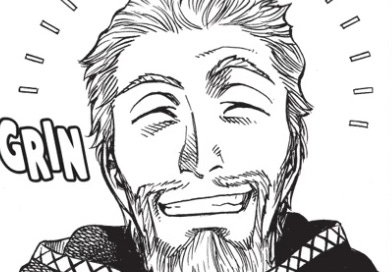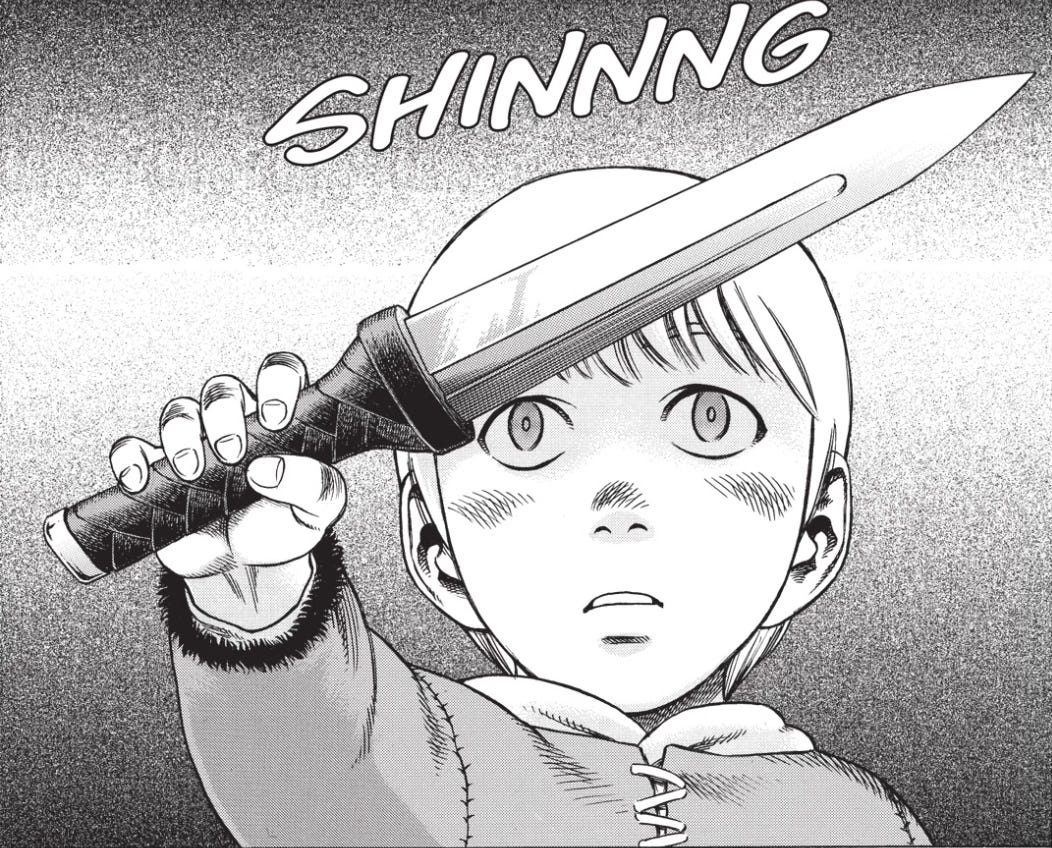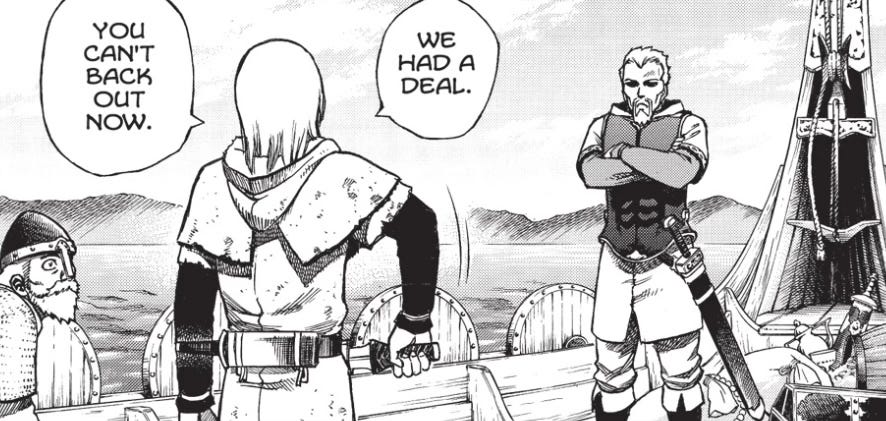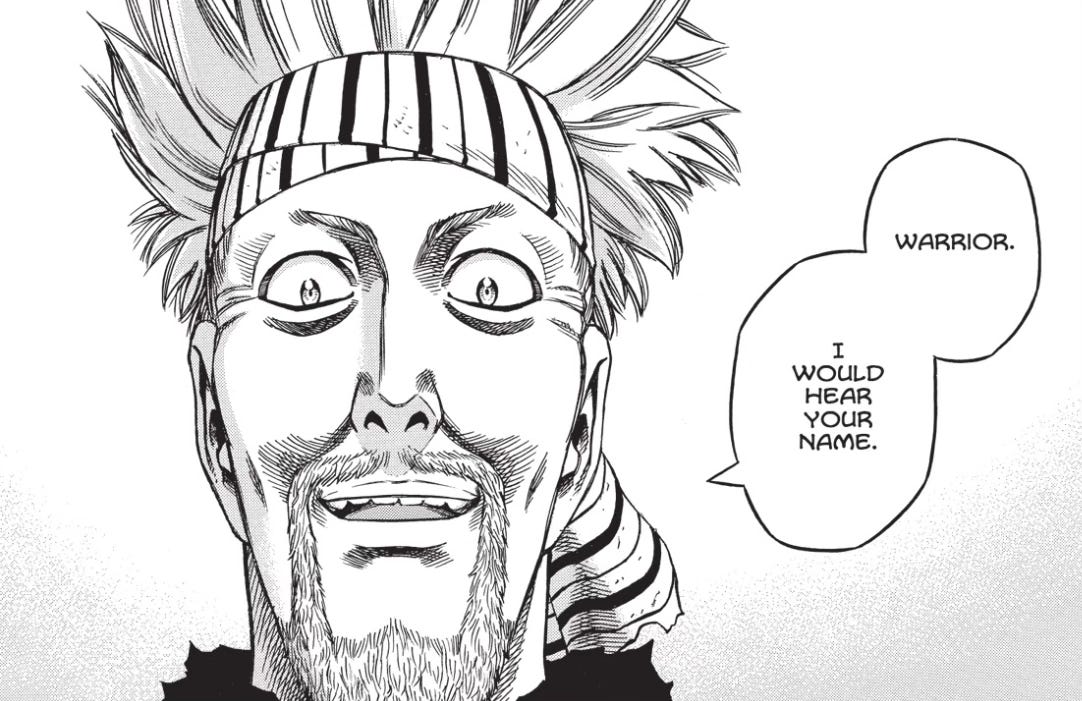Preface
I’ve started to take inventory of why I step away from stories or series, and why I can’t turn away from others. Even when I love characters, or setting, I often still stray and dabble in something else, seeking that little nugget I couldn’t find.
That nugget is tension, and Vinland Saga taught me just how important that central nugget of tension really is. But not only what it is, but how close it is. Even amidst loving DandaDan, keeping up with Kaiju No. 8 and Blue Lock and Gachiakuta, and revisiting Chainsaw Man, it was Vinland Saga that kept claiming my attention most.
Even as I questioned what I even liked about the protagonist, Thorfinn. But I wasn’t in the story for him, he’s just the vessel with which the story is told. What I actually loved is the device that Thorfinn is to producing sustained tension.
Preface over!
Maybe this goes without saying, maybe it doesn’t, but let me just say it right off the bat—conflict is everything in a story. Whether it’s a macro conflict like the destruction of the galaxy, or a micro conflict, like the construction of a cozy house, every story needs something to accomplish. That’s the whole point of a story.
Even still, while not all conflict is created equally, the basic notion of having a central conflict is. Avatar: The Last Airbender is a great example of central conflict that never really leaves the immediate scope of the story. Aang is always destined to face Fire Lord Ozai. No matter what happens, or where they go, he is always aware of this inevitability.
Part of the reason that story is so great, they never have to reinvent the arc. Reinventing new conflict is always a tough ask, because every new arc has to, ideally, one-up the previous conflict arc. Otherwise what’s the point.
To contrast Avatar: The Last Airbender, The Legends of Korra has four distinct conflict arcs, but remarkably, each one one-ups the previous to create a fantastic storyline. Not all stories do that so well. In fact, few other multi-arc series do.
Thinking in terms of central conflict and how it sustains tension, there’s one place we have to start, and that place is character dynamics.
Character dynamics are everything to tension. How characters interact with each other, sure, but also what they stand to gain or lose from one another. It’s why Blue Lock was such an immediate draw for me. Such an immediate draw that this question of central tension and character dynamics was what inspired me to start MangaCraft in the first place. It was my first article… see?
The basic idea being how fun it is that every single character in the story is fighting for the same thing, and only one can have it. Yet they’re all becoming friends in the meantime. It’s quite the dynamic, and one that supplies constant tension.
Hell’s Paradise offers another example of character dynamics sprouting centralized tension. Their character dynamics initially come in pairs. Every criminal has a guard/executioner who is ordered to kill them if they step out of line. Even as they face this brutal and unforgiving island ripe with death. That’s straight tension all the time.
But those are sources of tension that are all-consuming. They’re everywhere, all the time, all at once.
Vinland Saga offers a different source of tension that’s more of a gold nugget in a sprawling world. And don’t worry, these aren’t really spoilers since it all happens literally right away, but a brief summary to catch you up if you haven’t read/watched.
Thorfinn, the son of Thors, witnesses his father being killed in a backhanded way by Askeladd, a Viking leader hired to snuff out Thors. To avenge his father, Thorfinn challenges Askeladd to a duel, but Askeladd doesn’t recognize Thorfinn as a warrior. He has to earn the right to duel him. So time passes, and Thorfinn essentially serves Askeladd in battle until he can defeat him in a duel.
It’s like having your protagonist and antagonist in constantly close proximity, almost connected at the hip. Along the way, they even learn stuff about each other, they talk, they may even slightly respect each other, but not Thorfinn, that dude is still beat up about Askeladd’s treachery. But regardless, he still tolerates him enough to let it sustain his quest, which supplies the constant source of close, central tension.
Just a hero and his sworn nemesis, walking around the English countryside, robbing folks.
Think about that though. That’s like if Frodo and Sauron had to travel together, or Harry and Voldemort. Can you imagine?
If you’re being nitpicky, sure, Askeladd isn’t pure evil like Sauron or Voldemort. He did an underhanded thing in the way he killed Thors without honor, but in the spirit of humanity, he is not good or bad, he’s gray. Still though, in the context of the story, this is, in the simplest terms, the good guy and the bad guy traveling together and literally working together, knowing that, in the end, they will duel to the death, even if they don’t know when that end is. Neither do we, for that matter. I’m not all the way through, Askeladd could be dead already for all I know, I don’t want to Google it.
Which is another thing, and this is on a personal level but I’m sharing it anyway—I seek out spoilers. Always. I don’t want to be surprised, I want to know what’s coming. This time though, I don’t want to know what happens to Askeladd because—and sorry to say this, Thorfinn—I really like Askeladd. Even though he’s the chief bad guy, the arch villain, he’s so much more human than Thorfinn’s linear thinking. He is a complex figure who is filling the father figure role in Thorfinn’s life, even though he killed Thorfinn’s actual dad.
Who does that? This guy.
Anyway, the point being that any given story is going to have numerous sources of conflict. In Vinland Saga, the war with England is ongoing, friends and foes come and go, side quests are won and lost, but that central conflict is ongoing, and it looms so large on the story that you never lose sight of it. That’s the rarity, not that there is a central conflict, every story has a central conflict, but it’s always right there in front of you.
To contrast, Lord of the Rings has an obvious central conflict—Frodo has to destroy the ring. But there are plenty of side quests and diversions. Helms Deep, the march of the Ents, etc. Sure, they all serve the purpose of Frodo destroying the ring, but when Legolas and Gimli are counting their kills in the spirit of competition, how much are you thinking about Frodo?
No matter what Thorfinn or Askeladd do, either together or individually, their central conflict is always right there, staring you in the face. It’s hard to do central tension any better than that. So if you’re looking for a way to keep readers sustained, just force your hero and villain to journey together despite having to one day fight to the death. It works every time. And by every time I mean the one time I’ve seen it.
Hey, creatives. Think about your central conflict, the one that’s at the heart of your story. Are there any scenes where the central conflict isn’t present? If so, how does that scene serve the story? Is there room in the scene to work in the central conflict?
Hey, fans of Vinland Saga. How do you feel about Thorfinn’s growth? I’m asking as someone who hasn’t seen the completion of his arc.









Vinland Saga is easily one of my favorite seinen manga. Glad to see you give Askeladd some praise, he's a criminally underrated antagonist.
Love this! And what fortuitous timing with Anime NYC today!